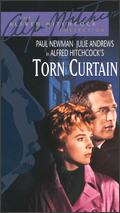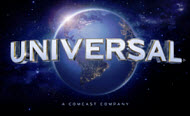Torn Curtain
Reviewed by: Brett Willis
STAFF WRITER
| Moral Rating: | Average |
| Moviemaking Quality: |
|
| Primary Audience: | Teen to Adult |
| Genre: | Spy Romance Thriller Drama |
| Length: | 2 hr. 5 min. |
| Year of Release: | 1965 |
| USA Release: |
July 27, 1966 |

| Featuring |
|---|
|
Paul Newman … Professor Michael Armstrong Julie Andrews … Sarah Sherman Lila Kedrova … Countess Kuchinska Hansjörg Felmy (Hansjoerg Felmy) … Heinrich Gerhard Tamara Toumanova … Ballerina Ludwig Donath … Professor Gustav Lindt Wolfgang Kieling … Hermann Gromek Günter Strack … Professor Karl Manfred David Opatoshu … Mr. Jacobi Gisela Fischer … Dr. Koska Mort Mills … Farmer Carolyn Conwell … Farmer’s Wife Arthur Gould-Porter … Freddy, the Bookseller Gloria Govrin (Gloria Gorvin) … Fräulein Mann |
| Director |
|
Alfred Hitchcock |
| Producer |
| Alfred Hitchcock |
| Distributor |
This spy film isn’t Hitchcock’s best work, but it’s well done within its type.
A pair of American research scientists, Michael Armstrong and Sarah Sherman (Paul Newman and Julie Andrews), end up behind the Iron Curtain (a nickname for the Soviet Union and its Eastern European satellite states), dealing in the secrets of antimissile defense technology. There’s not much more I can say without revealing major plot points; one of the few suspense elements is the question of who’s on whose side.
Content notes: Michael and Sarah, who are engaged, are in bed together in an opening scene (there’s no visible nudity; most of the time, the covers are pulled up to their necks). They both utter some mild curses in the first scenes. From there on, the film is a fairly clean cat-and-mouse spy story except for one long on-screen killing (the person being killed is strong and hardy, so the killers have to use a combination of methods). On the positive side: We see people who risk their own safety for the welfare of their country or for the way of life that they believe in.
Background: During the 1960s (the setting of this film), conservatives in the U.S. fought for implementation of an antimissile defense system, but were defeated by those who said that the Soviet Union would view such an action as “escalation” and by a false public belief that such a system was already in place. Then in 1972 the U.S. and U.S.S.R. signed a treaty forbidding either side from developing antimissile missiles. That meant that the only nuclear deterrent was “Mutual Assured Destruction” (MAD). But in the ’80s, President Reagan announced an initiative for a satellite-based laser antimissile system (dubbed “Star Wars” by its critics), which apparently hastened the end of the Cold War and the breakup of the Soviet Union because the Soviets found it impossible to keep up with our re-armament program. Yet even now, in the 21st Century, Russia and the U.S. still haggle over the rules for antimissile defenses; and we’re also told that if we implement such a defense, China and the minor nuclear powers will all build up their arsenals in an attempt to overwhelm it.
Personally, I believe it’s better to bargain from a position of strength than from one of weakness. And I agree with President Reagan that a good antimissile system would render offensive nuclear weapons (or at least nuclear missiles) obsolete. Maybe some of us will actually live to see that happen.


PLEASE share your observations and insights to be posted here.

